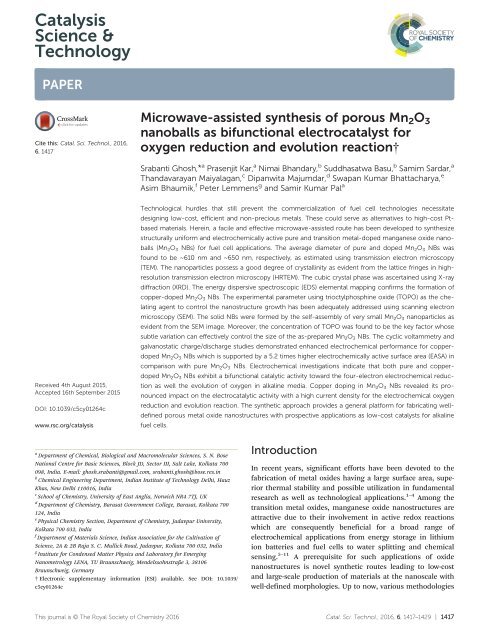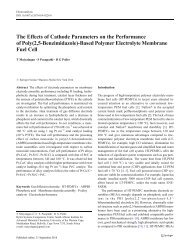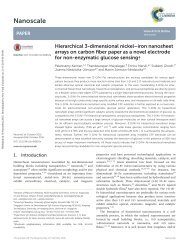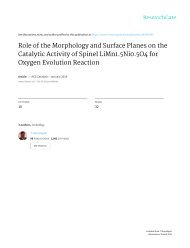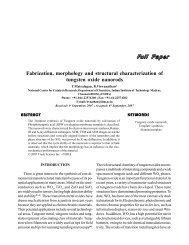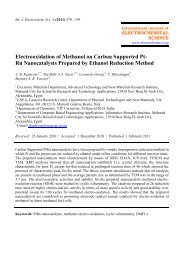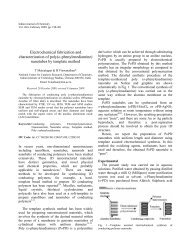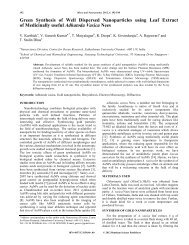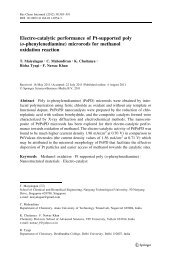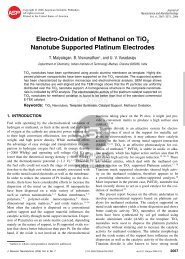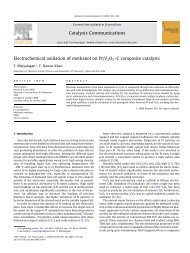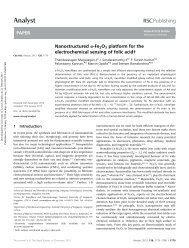Microwave-assisted synthesis of porous Mn 2 O 3 nanoballs as bifunctional electrocatalyst for oxygen reduction and evolution reaction - Copy
Create successful ePaper yourself
Turn your PDF publications into a flip-book with our unique Google optimized e-Paper software.
Catalysis<br />
Science &<br />
Technology<br />
PAPER<br />
Cite this: Catal. Sci. Technol., 2016,<br />
6, 1417<br />
<strong>Microwave</strong>-<strong><strong>as</strong>sisted</strong> <strong>synthesis</strong> <strong>of</strong> <strong>porous</strong> <strong>Mn</strong> 2 O 3<br />
<strong>nanoballs</strong> <strong>as</strong> <strong>bifunctional</strong> <strong>electrocatalyst</strong> <strong>for</strong><br />
<strong>oxygen</strong> <strong>reduction</strong> <strong>and</strong> <strong>evolution</strong> <strong>reaction</strong>†<br />
Srabanti Ghosh,* a Pr<strong>as</strong>enjit Kar, a Nimai Bh<strong>and</strong>ary, b Suddh<strong>as</strong>atwa B<strong>as</strong>u, b Samim Sardar, a<br />
Th<strong>and</strong>avarayan Maiyalagan, c Dipanwita Majumdar, d Swapan Kumar Bhattacharya, e<br />
Asim Bhaumik, f Peter Lemmens g <strong>and</strong> Samir Kumar Pal a<br />
Received 4th August 2015,<br />
Accepted 16th September 2015<br />
DOI: 10.1039/c5cy01264c<br />
www.rsc.org/catalysis<br />
Technological hurdles that still prevent the commercialization <strong>of</strong> fuel cell technologies necessitate<br />
designing low-cost, efficient <strong>and</strong> non-precious metals. These could serve <strong>as</strong> alternatives to high-cost Ptb<strong>as</strong>ed<br />
materials. Herein, a facile <strong>and</strong> effective microwave-<strong><strong>as</strong>sisted</strong> route h<strong>as</strong> been developed to synthesize<br />
structurally uni<strong>for</strong>m <strong>and</strong> electrochemically active pure <strong>and</strong> transition metal-doped manganese oxide <strong>nanoballs</strong><br />
(<strong>Mn</strong> 2 O 3 NBs) <strong>for</strong> fuel cell applications. The average diameter <strong>of</strong> pure <strong>and</strong> doped <strong>Mn</strong> 2 O 3 NBs w<strong>as</strong><br />
found to be ~610 nm <strong>and</strong> ~650 nm, respectively, <strong>as</strong> estimated using transmission electron microscopy<br />
(TEM). The nanoparticles possess a good degree <strong>of</strong> crystallinity <strong>as</strong> evident from the lattice fringes in highresolution<br />
transmission electron microscopy (HRTEM). The cubic crystal ph<strong>as</strong>e w<strong>as</strong> <strong>as</strong>certained using X-ray<br />
diffraction (XRD). The energy dispersive spectroscopic (EDS) elemental mapping confirms the <strong>for</strong>mation <strong>of</strong><br />
copper-doped <strong>Mn</strong> 2 O 3 NBs. The experimental parameter using trioctylphosphine oxide (TOPO) <strong>as</strong> the chelating<br />
agent to control the nanostructure growth h<strong>as</strong> been adequately addressed using scanning electron<br />
microscopy (SEM). The solid NBs were <strong>for</strong>med by the self-<strong>as</strong>sembly <strong>of</strong> very small <strong>Mn</strong> 2 O 3 nanoparticles <strong>as</strong><br />
evident from the SEM image. Moreover, the concentration <strong>of</strong> TOPO w<strong>as</strong> found to be the key factor whose<br />
subtle variation can effectively control the size <strong>of</strong> the <strong>as</strong>-prepared <strong>Mn</strong> 2 O 3 NBs. The cyclic voltammetry <strong>and</strong><br />
galvanostatic charge/discharge studies demonstrated enhanced electrochemical per<strong>for</strong>mance <strong>for</strong> copperdoped<br />
<strong>Mn</strong> 2 O 3 NBs which is supported by a 5.2 times higher electrochemically active surface area (EASA) in<br />
comparison with pure <strong>Mn</strong> 2 O 3 NBs. Electrochemical investigations indicate that both pure <strong>and</strong> copperdoped<br />
<strong>Mn</strong> 2 O 3 NBs exhibit a <strong>bifunctional</strong> catalytic activity toward the four-electron electrochemical <strong>reduction</strong><br />
<strong>as</strong> well the <strong>evolution</strong> <strong>of</strong> <strong>oxygen</strong> in alkaline media. Copper doping in <strong>Mn</strong> 2 O 3 NBs revealed its pronounced<br />
impact on the electrocatalytic activity with a high current density <strong>for</strong> the electrochemical <strong>oxygen</strong><br />
<strong>reduction</strong> <strong>and</strong> <strong>evolution</strong> <strong>reaction</strong>. The synthetic approach provides a general plat<strong>for</strong>m <strong>for</strong> fabricating welldefined<br />
<strong>porous</strong> metal oxide nanostructures with prospective applications <strong>as</strong> low-cost catalysts <strong>for</strong> alkaline<br />
fuel cells.<br />
a Department <strong>of</strong> Chemical, Biological <strong>and</strong> Macromolecular Sciences, S. N. Bose<br />
National Centre <strong>for</strong> B<strong>as</strong>ic Sciences, Block JD, Sector III, Salt Lake, Kolkata 700<br />
098, India. E-mail: ghosh.srabanti@gmail.com, srabanti.ghosh@bose.res.in<br />
b Chemical Engineering Department, Indian Institute <strong>of</strong> Technology Delhi, Hauz<br />
Kh<strong>as</strong>, New Delhi 110016, India<br />
c School <strong>of</strong> Chemistry, University <strong>of</strong> E<strong>as</strong>t Anglia, Norwich NR4 7TJ, UK<br />
d Department <strong>of</strong> Chemistry, Bar<strong>as</strong>at Government College, Bar<strong>as</strong>at, Kolkata 700<br />
124, India<br />
e Physical Chemistry Section, Department <strong>of</strong> Chemistry, Jadavpur University,<br />
Kolkata 700 032, India<br />
f Department <strong>of</strong> Materials Science, Indian Association <strong>for</strong> the Cultivation <strong>of</strong><br />
Science, 2A & 2B Raja S. C. Mullick Road, Jadavpur, Kolkata 700 032, India<br />
g Institute <strong>for</strong> Condensed Matter Physics <strong>and</strong> Laboratory <strong>for</strong> Emerging<br />
Nanometrology LENA, TU Braunschweig, Mendelssohnstraße 3, 38106<br />
Braunschweig, Germany<br />
† Electronic supplementary in<strong>for</strong>mation (ESI) available. See DOI: 10.1039/<br />
c5cy01264c<br />
Introduction<br />
In recent years, significant ef<strong>for</strong>ts have been devoted to the<br />
fabrication <strong>of</strong> metal oxides having a large surface area, superior<br />
thermal stability <strong>and</strong> possible utilization in fundamental<br />
research <strong>as</strong> well <strong>as</strong> technological applications. 1–4 Among the<br />
transition metal oxides, manganese oxide nanostructures are<br />
attractive due to their involvement in active redox <strong>reaction</strong>s<br />
which are consequently beneficial <strong>for</strong> a broad range <strong>of</strong><br />
electrochemical applications from energy storage in lithium<br />
ion batteries <strong>and</strong> fuel cells to water splitting <strong>and</strong> chemical<br />
sensing. 5–11 A prerequisite <strong>for</strong> such applications <strong>of</strong> oxide<br />
nanostructures is novel synthetic routes leading to low-cost<br />
<strong>and</strong> large-scale production <strong>of</strong> materials at the nanoscale with<br />
well-defined morphologies. Up to now, various methodologies<br />
This journal is © The Royal Society <strong>of</strong> Chemistry 2016<br />
Catal. Sci. Technol., 2016,6, 1417–1429 | 1417
Paper<br />
have been employed to synthesize manganese oxide; however,<br />
most <strong>of</strong> these complicated synthetic procedures are <strong>as</strong>sociated<br />
with high-temperature <strong>synthesis</strong>, low yield <strong>and</strong> they are<br />
time-consuming. 11–13<br />
The development <strong>of</strong> sustainable synthetic processes using<br />
alternative energy inputs <strong>and</strong> greener <strong>reaction</strong> media h<strong>as</strong><br />
been recognized <strong>as</strong> an alternative approach <strong>for</strong> large-scale<br />
production <strong>of</strong> functional materials. 14–16 In this regard, the<br />
microwave-<strong><strong>as</strong>sisted</strong> hydrothermal (MAH) method <strong>of</strong>fers a<br />
rapid <strong>and</strong> highly reproducible technique <strong>for</strong> the preparation<br />
<strong>of</strong> metal oxide nanomaterials with several advantages such <strong>as</strong><br />
reduced energy consumption, shorter <strong>reaction</strong> time <strong>and</strong><br />
higher product yield. 17–19 The microwave-<strong><strong>as</strong>sisted</strong> <strong>synthesis</strong><br />
<strong>of</strong> metal oxide nanostructures with various morphologies<br />
such <strong>as</strong> Co 3 O 4, <strong>Mn</strong>O 2 <strong>and</strong> TiO 2 , etc., h<strong>as</strong> been well documented<br />
in the literature. 17,20 Rapid <strong>synthesis</strong> <strong>of</strong> ZnO nanostructures<br />
using a microwave-<strong><strong>as</strong>sisted</strong> approach to accelerate<br />
nucleation <strong>and</strong> growth h<strong>as</strong> been previously reported by our<br />
group. 21 Although microwave-<strong><strong>as</strong>sisted</strong> growth h<strong>as</strong> been in<br />
vogue <strong>for</strong> preparation <strong>of</strong> various metal oxide nanostructures<br />
<strong>for</strong> the p<strong>as</strong>t decade, the reports regarding manganese oxides<br />
are scarce. 19,22,23 Here, we have reported the <strong>synthesis</strong> <strong>of</strong><br />
<strong>porous</strong> <strong>Mn</strong> 2 O 3 <strong>nanoballs</strong> (NBs) through a microwave-<strong><strong>as</strong>sisted</strong><br />
route, which are useful <strong>for</strong> electrocatalytic applications.<br />
The implementation <strong>of</strong> environmentally-friendly clean<br />
energy technologies is a vital issue <strong>and</strong> an alternative to traditional<br />
fossil fuel, <strong>as</strong> fuel cell devices endow efficient clean<br />
energy production <strong>and</strong> conversion. 24,25 A considerable number<br />
<strong>of</strong> nanomaterials with superior electrocatalytic activity are<br />
emerging <strong>as</strong> a new cl<strong>as</strong>s <strong>of</strong> electrode materials to fulfill the<br />
incre<strong>as</strong>ing dem<strong>and</strong>s <strong>for</strong> high power conversion <strong>and</strong> durability.<br />
15,16,26 Recently, there h<strong>as</strong> been immense interest in the<br />
design <strong>and</strong> development <strong>of</strong> highly efficient <strong>oxygen</strong> <strong>reduction</strong><br />
<strong>reaction</strong> (ORR) <strong>and</strong> <strong>oxygen</strong> <strong>evolution</strong> <strong>reaction</strong> (OER) catalysts<br />
which can resolve the crucial issues related to fuel cells<br />
<strong>and</strong> rechargeable metal–air batteries. 27 Pt-b<strong>as</strong>ed metals or<br />
alloys are regarded <strong>as</strong> robust <strong>and</strong> efficient catalysts <strong>for</strong> oxidation<br />
<strong>reaction</strong>s but their high cost <strong>and</strong> limited abundance<br />
necessitate the exploitation <strong>of</strong> new non-precious metal catalysts.<br />
28 On the other h<strong>and</strong>, precious metal oxide nanomaterials<br />
such <strong>as</strong> iridium dioxide (IrO 2 ) <strong>and</strong> ruthenium dioxide<br />
(RuO 2 ) have demonstrated the best overall per<strong>for</strong>mance<br />
<strong>for</strong> catalyzing ORR <strong>and</strong> OER. 29,30 Despite this activity, the<br />
development <strong>of</strong> an active material via a naturally abundant<br />
<strong>and</strong> economically viable method h<strong>as</strong> remained an unresolved<br />
issue in energy conversion applications. In fact, the <strong>oxygen</strong><br />
<strong>reduction</strong> <strong>reaction</strong> is a challenging <strong>reaction</strong> due to slower<br />
ORR kinetics <strong>and</strong> the stability <strong>of</strong> the cathode catalyst material<br />
under cycling in acidic or alkaline conditions during operation.<br />
However, one critical issue to be addressed is the lack<br />
<strong>of</strong> effective <strong>electrocatalyst</strong>s <strong>for</strong> the four-electron (4e − ) <strong>reduction</strong><br />
<strong>of</strong> O 2 (ORR) at a relatively low overpotential. 31 Accordingly,<br />
non-precious transition metal oxides <strong>and</strong> in particular,<br />
manganese oxides (<strong>Mn</strong>O x ) have been regarded <strong>as</strong> alternative<br />
ORR catalysts with re<strong>as</strong>onable catalytic activity, low cost, <strong>and</strong><br />
structural stability <strong>for</strong> primary alkaline-b<strong>as</strong>ed fuel cells. 32–36<br />
In contr<strong>as</strong>t to other manganese oxides (<strong>Mn</strong> 3 O 4 or <strong>Mn</strong>O 2 ), little<br />
attention h<strong>as</strong> been paid to exploring the potential <strong>of</strong> the<br />
catalytic activity <strong>of</strong> <strong>Mn</strong> 2 O 3 nanostructured materials. 33–35 Suib<br />
et al. reported a manganese oxide (<strong>Mn</strong>O 2 ) catalyst having a<br />
dual nature (OER <strong>and</strong> ORR catalysis), a potential alternative<br />
<strong>for</strong> high-cost Pt <strong>and</strong> its alloys, iridium, <strong>and</strong> ruthenium oxide<br />
catalysts. 36 Recently, mixed metal oxides displaying excellent<br />
catalytic activities have been investigated <strong>as</strong> one <strong>of</strong> the most<br />
promising c<strong>and</strong>idates <strong>for</strong> ORR in an alkaline medium. 37,38<br />
Muhler et al. described the excellent electrocatalytic activities<br />
<strong>of</strong> cobalt–manganese-b<strong>as</strong>ed spinels <strong>as</strong> synergistic <strong>bifunctional</strong><br />
catalysts <strong>for</strong> OER <strong>and</strong> ORR. 39<br />
In the present study, we developed a simple <strong>and</strong> convenient<br />
microwave-<strong><strong>as</strong>sisted</strong> approach <strong>for</strong> the controlled <strong>synthesis</strong><br />
<strong>of</strong> pure <strong>and</strong> metal-doped <strong>Mn</strong> 2 O 3 balls at the nanoscale.<br />
The structure <strong>and</strong> chemical composition have been studied<br />
along with the growth process <strong>and</strong> the merits <strong>of</strong> the MAH<br />
method using trioctylphosphine oxide (TOPO) <strong>as</strong> the chelating<br />
agent <strong>for</strong> the <strong>for</strong>mation <strong>of</strong> <strong>Mn</strong> 2 O 3 <strong>nanoballs</strong> are<br />
highlighted. To the best <strong>of</strong> our knowledge, this is the first<br />
report on the <strong>synthesis</strong> <strong>of</strong> <strong>porous</strong> <strong>Mn</strong> 2 O 3 nanostructures with<br />
controlled shape <strong>and</strong> composition by the MAH method. A<br />
systematic investigation h<strong>as</strong> been conducted in order to control<br />
the average size <strong>of</strong> the <strong>Mn</strong> 2 O 3 nanostructures by optimizing<br />
the concentration <strong>of</strong> the chelating agent (TOPO) <strong>and</strong><br />
moreover, a mechanism <strong>of</strong> the <strong>for</strong>mation <strong>of</strong> the <strong>nanoballs</strong><br />
h<strong>as</strong> also been proposed. The cyclic voltammetry me<strong>as</strong>urements<br />
have been employed to investigate the electrocatalytic<br />
activity <strong>of</strong> these <strong>Mn</strong> 2 O 3 nanostructures <strong>for</strong> both <strong>oxygen</strong> <strong>reduction</strong><br />
<strong>and</strong> <strong>evolution</strong> <strong>reaction</strong>.<br />
Materials <strong>and</strong> methods<br />
Catalysis Science & Technology<br />
Materials<br />
Manganese acetate dihydrate, copper chloride dihydrate,<br />
n-trioctylphosphine oxide (TOPO, 99%), <strong>and</strong> Nafion were purch<strong>as</strong>ed<br />
from Sigma Aldrich. Pot<strong>as</strong>sium bromide, ethylene glycol<br />
(EG), sodium sulfate <strong>and</strong> absolute alcohol were obtained<br />
from Merck. All other chemicals employed were <strong>of</strong> analytical<br />
grade <strong>and</strong> used without further purification.<br />
Synthesis <strong>of</strong> <strong>Mn</strong> 2 O 3<br />
In a typical <strong>synthesis</strong> <strong>of</strong> <strong>Mn</strong> 2 O 3 , 0.03 mol manganese acetate<br />
dihydrate <strong>and</strong> 0.12 mol n-trioctylphosphine oxide were<br />
dissolved in 30 ml <strong>of</strong> ethylene glycol. The resultant mixture<br />
w<strong>as</strong> continuously stirred <strong>for</strong> 2 hours <strong>and</strong> then transferred<br />
into a 30 mL Teflon-lined stainless-steel autoclave. EG h<strong>as</strong><br />
been a selected <strong>as</strong> a polar <strong>and</strong> high microwave absorbing<br />
solvent. The Teflon-lined autoclave w<strong>as</strong> microwave-heated to<br />
120 °C <strong>and</strong> maintained at this temperature <strong>for</strong> 5 hours. The<br />
final product w<strong>as</strong> collected <strong>and</strong> w<strong>as</strong>hed with distilled water<br />
<strong>and</strong> absolute alcohol at le<strong>as</strong>t three times. Then the <strong>as</strong>prepared<br />
samples were further annealed at 450 °C <strong>for</strong> 6 hours<br />
in air. The effect <strong>of</strong> TOPO concentration on the <strong>for</strong>mation <strong>of</strong><br />
<strong>Mn</strong> 2 O 3 w<strong>as</strong> studied by preparing precursors with different<br />
molar ratios <strong>of</strong> <strong>Mn</strong> 2+ : TOPO <strong>of</strong> 1 : 1, 1 : 2 <strong>and</strong> 1 : 4. The<br />
1418 | Catal. Sci. Technol., 2016,6, 1417–1429 This journal is © The Royal Society <strong>of</strong> Chemistry 2016
Catalysis Science & Technology<br />
<strong>synthesis</strong> <strong>of</strong> copper ion-doped manganese oxide <strong>nanoballs</strong><br />
(designated <strong>as</strong> Cu–<strong>Mn</strong> 2 O 3 NBs) w<strong>as</strong> made by addition <strong>of</strong><br />
0.003 M copper chloride dihydrate under similar <strong>reaction</strong><br />
conditions. In another set, 0.03 mol manganese acetate dehydrate<br />
<strong>and</strong> 1.2 mol urea were added into 30 ml <strong>of</strong> ethylene glycol<br />
to prepare <strong>Mn</strong> 2 O 3 without using TOPO.<br />
Characterization<br />
Transmission electron microscopy (TEM) grids were prepared<br />
by applying a diluted drop <strong>of</strong> the <strong>Mn</strong> 2 O 3 <strong>and</strong> Cu–<strong>Mn</strong> 2 O 3 samples<br />
to carbon-coated copper grids. Field Emission Scanning<br />
Electron Microscopy (FESEM, QUANTA FEG 250) investigations<br />
were per<strong>for</strong>med by applying a diluted drop <strong>of</strong> <strong>Mn</strong> 2 O 3<br />
<strong>and</strong> Cu–<strong>Mn</strong> 2 O 3 <strong>nanoballs</strong> on silicon wafer. The ph<strong>as</strong>e structures<br />
<strong>of</strong> the <strong>as</strong>-prepared samples were determined by powder<br />
X-ray diffraction (XRD, PANalytical XPERTPRO diffractometer<br />
equipped with Cu Kα radiation at 40 mA <strong>and</strong> 40 kV, <strong>and</strong> a<br />
scanning rate <strong>of</strong> 0.02° S −1 in the 2θ range from 20° to 80°).<br />
The FTIR spectra <strong>of</strong> the <strong>as</strong>-prepared samples were recorded<br />
on a JASCO FTIR-6300 spectrometer, using KBr pellets. The<br />
thermal gravimetric analysis (TGA) <strong>of</strong> <strong>Mn</strong> 2 O 3 solid powder<br />
w<strong>as</strong> per<strong>for</strong>med under nitrogen atmosphere with a heating<br />
rate <strong>of</strong> 10 °C min −1 from 30 °C to 1000 °C by using a Perkin-<br />
Elmer TGA-50H. A Quantachrome Autosorb 1-C w<strong>as</strong> used to<br />
record the N 2 adsorption/desorption isotherm <strong>of</strong> the sample.<br />
The sample w<strong>as</strong> deg<strong>as</strong>sed at 200 °C <strong>for</strong> 8 h under high vacuum<br />
conditions prior to the me<strong>as</strong>urement.<br />
Electrochemical me<strong>as</strong>urements<br />
For voltammetry me<strong>as</strong>urements, a three-electrode cell w<strong>as</strong><br />
used with Ag/AgCl <strong>as</strong> the reference electrode <strong>and</strong> a Pt wire <strong>as</strong><br />
the counter electrode. The electrolyte comprised <strong>of</strong> a 0.5 M<br />
aqueous Na 2 SO 4 solution. The working electrode w<strong>as</strong> fabricated<br />
by coating catalysts on a gl<strong>as</strong>sy carbon substrate. For<br />
electrode preparation, 2 mg <strong>of</strong> <strong>Mn</strong> 2 O 3 <strong>and</strong> Cu–<strong>Mn</strong> 2 O 3 were<br />
dissolved in 20 μl <strong>of</strong> ethanol containing 5 wt% Nafion <strong>as</strong> a<br />
binder. Then 10 μl <strong>of</strong> sample solution w<strong>as</strong> deposited on the<br />
gl<strong>as</strong>sy carbon (working electrode). A multichannel<br />
potentiostat–galvanostat system (AutoLab 302 N) w<strong>as</strong> used<br />
<strong>for</strong> cyclic voltammetry (CV) <strong>and</strong> <strong>for</strong> charge–discharge cycling<br />
studies in a potential window <strong>of</strong> −0.2 to 0.8 <strong>and</strong> at different<br />
scan rates <strong>of</strong> 5–50 mV s −1 .<br />
To evaluate the electrochemical activity <strong>for</strong> the ORR <strong>of</strong><br />
<strong>Mn</strong> 2 O 3, rotating disk electrode (RDE) experiments were<br />
per<strong>for</strong>med. Pt wire <strong>and</strong> Ag/AgCl (Sat. KCl) were used <strong>as</strong> the<br />
counter <strong>and</strong> reference electrodes, respectively, <strong>and</strong> 0.1 M<br />
KOH w<strong>as</strong> used <strong>as</strong> an electrolyte. High-purity O 2 g<strong>as</strong> w<strong>as</strong><br />
purged <strong>for</strong> 30 mins be<strong>for</strong>e each RDE experiment to make the<br />
electrolyte saturated with O 2 . A rotating disk electrode<br />
voltammetric study w<strong>as</strong> carried out using a RRDE-3A Rotating<br />
Ring Disk Electrode Apparatus (BioLogic Science Instruments,<br />
France) connected to a DY2300 potentiostat (Digi-Ivy<br />
Inc., USA) at a scan rate <strong>of</strong> 10 mV s −1 <strong>and</strong> potential range<br />
from 0 to −0.6 V. A catalyst ink w<strong>as</strong> prepared by ultr<strong>as</strong>onically<br />
mixing 6.0 mg <strong>of</strong> <strong>Mn</strong> 2 O 3 sample with 3 mL <strong>of</strong> pure deionized<br />
water <strong>and</strong> 10 μL <strong>of</strong> 5 wt% Nafion solution <strong>for</strong> 1 h in order to<br />
make a homogeneous suspension. Then, 5 μL <strong>of</strong> prepared<br />
catalytic ink w<strong>as</strong> transferred to the surface <strong>of</strong> a gl<strong>as</strong>sy carbon<br />
electrode <strong>of</strong> 3 mm diameter using a micropipette. Finally, the<br />
ink w<strong>as</strong> allowed to dry <strong>for</strong> 10 min at room temperature to<br />
<strong>for</strong>m a thin catalyst film on a gl<strong>as</strong>sy carbon electrode <strong>as</strong> a<br />
working electrode.<br />
To evaluate the electrochemical activity <strong>for</strong> the <strong>oxygen</strong> <strong>evolution</strong><br />
<strong>reaction</strong> (OER) <strong>of</strong> the <strong>Mn</strong> 2 O 3 , rotating disk electrode<br />
(RDE) experiments were per<strong>for</strong>med under saturated N 2 . Pt<br />
wire <strong>and</strong> Ag/AgCl (saturated KCl) were used <strong>as</strong> the counter<br />
<strong>and</strong> reference electrodes, respectively, <strong>and</strong> 0.1 M KOH w<strong>as</strong><br />
used <strong>as</strong> an electrolyte. 40 Electrochemical characterization w<strong>as</strong><br />
conducted using a single potentiostat with a scan rate <strong>of</strong> 10<br />
mV s −1 <strong>and</strong> a potential range from 0 to 1 V. The ink w<strong>as</strong> prepared<br />
according to the method described above <strong>for</strong> the ORR.<br />
Koutecky–Levich plots (J −1 vs. ω −1/2 ) were analyzed at various<br />
electrode potentials. The slopes <strong>of</strong> their best linear fit lines<br />
were used to calculate the number <strong>of</strong> electrons transferred<br />
(n) on the b<strong>as</strong>is <strong>of</strong> the Koutecky–Levich equation: 41 (1)<br />
(2)<br />
j K = nFkC 0 (3)<br />
where j (mA cm −2 ) is the me<strong>as</strong>ured current density, j K <strong>and</strong> j L<br />
(mA cm −2 ) are the kinetic <strong>and</strong> diffusion-limiting current densities,<br />
ω is the angular velocity <strong>of</strong> the rotating disk (ω =2πN,<br />
N is the linear rotating speed in rpm), n is the overall number<br />
<strong>of</strong> electrons transferred in ORR, F is the Faraday constant (96<br />
485 °C mol −1 ), C 0 is the bulk concentration <strong>of</strong> O 2 (1.2 × 10 −6<br />
mol cm −3 ), D 0 is diffusion coefficient <strong>of</strong> O 2 (1.9 × 10 −5 cm 2<br />
s −1 ), ν is the kinematic viscosity <strong>of</strong> the electrolyte (0.01 cm 2<br />
s −1 ), <strong>and</strong> k is the electron transfer rate constant. 42 According<br />
to eqn (1) <strong>and</strong> (2), the number <strong>of</strong> electrons transferred<br />
(n) <strong>and</strong> the kinetic-limiting current j K can be obtained<br />
from the slope <strong>and</strong> intercept <strong>of</strong> the Koutecky–Levich plots<br />
(J -1 versus ω −1/2 ).<br />
Results <strong>and</strong> discussion<br />
Paper<br />
Synthesis <strong>and</strong> characterization <strong>of</strong> <strong>Mn</strong> 2 O 3 nanostructures<br />
The <strong>Mn</strong> 2 O 3 <strong>and</strong> Cu-doped <strong>Mn</strong> 2 O 3 were synthesized by a<br />
microwave-<strong><strong>as</strong>sisted</strong> hydrothermal method <strong>and</strong> the structural<br />
<strong>as</strong> well <strong>as</strong> the electrochemical properties <strong>of</strong> the <strong>as</strong>-prepared<br />
oxide samples were examined by common techniques <strong>as</strong><br />
discussed below. The sizes <strong>and</strong> morphologies <strong>of</strong> the <strong>Mn</strong> 2 O 3<br />
samples were characterized by transmission electron microscopy<br />
(TEM) (Fig. 1).<br />
This journal is © The Royal Society <strong>of</strong> Chemistry 2016<br />
Catal. Sci. Technol., 2016,6, 1417–1429 | 1419
Paper<br />
Catalysis Science & Technology<br />
Fig. 1 Transmission electron microscopy (TEM) images <strong>of</strong> <strong>Mn</strong> 2 O 3 <strong>and</strong> Cu-doped <strong>Mn</strong> 2 O 3 <strong>nanoballs</strong>. (a) <strong>and</strong> (b) TEM images at different magnifications<br />
<strong>and</strong> (c) HRTEM image <strong>of</strong> <strong>Mn</strong> 2 O 3 NBs. (d) <strong>and</strong> (e) TEM images at different magnifications <strong>and</strong> (f) HRTEM image <strong>of</strong> Cu–<strong>Mn</strong> 2 O 3 NBs.<br />
Fig. 1a illustrates the <strong>for</strong>mation <strong>of</strong> the well-ordered spherical<br />
type <strong>Mn</strong> 2 O 3 <strong>nanoballs</strong> (NBs) with a mean diameter <strong>of</strong><br />
550–620 nm. As evident from Fig. 1b, the NBs were fabricated<br />
by the aggregation <strong>of</strong> small particles, which presumably led<br />
to a rough surface. In addition, the intrinsic crystal structure<br />
<strong>of</strong> the <strong>as</strong>-prepared NBs w<strong>as</strong> further characterized by highresolution<br />
transmission electron microscopy (HRTEM). As<br />
shown in Fig. 1c, the interplanar distance between the fringes<br />
is found to be about 0.27 nm consistent with the (222) planes<br />
<strong>of</strong> <strong>Mn</strong> 2 O 3 . 13 The similar structure <strong>of</strong> <strong>Mn</strong> 2 O 3 after Cu doping<br />
<strong>as</strong> revealed by the representative TEM images (Fig. 1d <strong>and</strong> e)<br />
suggests that doping might have not influenced the growth<br />
<strong>of</strong> the NBs. The Cu–<strong>Mn</strong> 2 O 3 NBs exhibited a slightly bigger<br />
size ranging from 550–650 nm. The HRTEM image also demonstrated<br />
the highly crystalline nature <strong>of</strong> Cu–<strong>Mn</strong> 2 O 3 NBs with<br />
a cubic ph<strong>as</strong>e (Fig. 1f). The shape <strong>of</strong> the NBs w<strong>as</strong> found to be<br />
small grains <strong>of</strong> 5–10 nm diameter. Hence, highly crystalline<br />
<strong>and</strong> pure cubic ph<strong>as</strong>e <strong>Mn</strong> 2 O 3 could be obtained under a mild<br />
temperature through the MAH <strong>synthesis</strong>.<br />
The X-ray diffraction (XRD) patterns were recorded to confirm<br />
the lattice facets <strong>of</strong> <strong>Mn</strong> 2 O 3 <strong>and</strong> Cu–<strong>Mn</strong> 2 O 3 . Fig. 2a shows<br />
the XRD patterns <strong>of</strong> pure <strong>and</strong> doped <strong>Mn</strong> 2 O 3 <strong>and</strong> the diffraction<br />
peak position could be readily indexed <strong>as</strong> a cubic ph<strong>as</strong>e<br />
<strong>Mn</strong> 2 O 3 crystal (JCPDS No. 41-1442). It is evident from the differences<br />
between the breadths <strong>of</strong> the XRD reflections that<br />
doping incre<strong>as</strong>es the crystallinity <strong>of</strong> the <strong>Mn</strong> 2 O 3 structures. No<br />
other impurity peaks have been detected in both c<strong>as</strong>es, indicating<br />
that the highly crystalline pure <strong>and</strong> metal-doped manganese<br />
oxides have been successfully synthesized using the<br />
microwave irradiation process. Moreover, FTIR analysis w<strong>as</strong><br />
carried out to investigate the chemical structure <strong>of</strong><br />
trioctylphosphine oxide (TOPO) after microwave irradiation<br />
followed by the <strong>Mn</strong> 2 O 3 NBs <strong>for</strong>mation. Fig. 2b illustrates the<br />
FTIR spectra <strong>of</strong> pure TOPO <strong>and</strong> annealed <strong>Mn</strong> 2 O 3 NBs. It<br />
appears that the b<strong>and</strong> at 1145 cm −1 (PO symmetric type)<br />
<strong>and</strong> 1468 cm −1 (CH 3 bending) <strong>of</strong> TOPO disappeared after<br />
microwave irradiation <strong>and</strong> followed by hydrothermal treatment,<br />
suggests the surface <strong>of</strong> NBs free from organic lig<strong>and</strong>s<br />
which can be ideal <strong>for</strong> catalytic application. 43<br />
Thermogravimetric analysis <strong>of</strong> <strong>Mn</strong> 2 O 3 powder showed a<br />
weight loss <strong>of</strong> ~8% up to 580 °C which should be attributed<br />
to the removal <strong>of</strong> surface-adsorbed water which is consistent<br />
with previous reports. 44 Moreover, the weight remains nearly<br />
unchanged which suggests a high thermal stability <strong>of</strong> the <strong>as</strong>prepared<br />
<strong>Mn</strong> 2 O 3 NBs (Fig. 2c). Similarly, Cu-doped <strong>Mn</strong> 2 O 3<br />
demonstrated a high thermal stability with ~5% weight loss<br />
up to 800 °C.<br />
Further, the N 2 adsorption–desorption me<strong>as</strong>urement w<strong>as</strong><br />
per<strong>for</strong>med to determine the surface area analyses <strong>of</strong> <strong>Mn</strong> 2 O 3<br />
NBs. As shown in Fig. 2d, a type IV isotherm with an H3 hysteresis<br />
loop can be observed which confirms the mesoporosity<br />
<strong>of</strong> <strong>Mn</strong> 2 O 3 NBs. Pore size distributions (PSD) <strong>of</strong><br />
<strong>Mn</strong> 2 O 3 NBs have been estimated by employing the non-local<br />
density functional theory (NLDFT) <strong>as</strong> shown in the inset <strong>of</strong><br />
Fig. 2d, which suggests mesopore diameters centered at 1.8<br />
nm <strong>and</strong> 3.7 nm. The Brunauer–Emmett–Teller (BET) surface<br />
area <strong>and</strong> pore volume are 22 m 2 g −1 <strong>and</strong> 0.038 cm 3 g −1 ,<br />
respectively, which are comparable with the manganese oxide<br />
nanostructures synthesized by other common methods. 45,46<br />
The FESEM images revealed that the <strong>Mn</strong> 2 O 3 h<strong>as</strong> a spherical<br />
morphology with a mean diameter <strong>of</strong> 600–860 nm<br />
(Fig. 3a). Moreover, at a higher magnification (Fig. 3b <strong>and</strong> c),<br />
it h<strong>as</strong> been found that these solid NBs were <strong>for</strong>med by the<br />
self-<strong>as</strong>sembly <strong>of</strong> very small nanoparticles <strong>as</strong> evident from the<br />
SEM image (Fig. 3b <strong>and</strong> c).<br />
<strong>Mn</strong> 2 O 3 demonstrated a homogeneous size distribution<br />
<strong>and</strong> the average diameter <strong>of</strong> the NBs prepared from 4 equivalents<br />
<strong>of</strong> TOPO (<strong>Mn</strong> 2+ : TOPO, 1 : 4) w<strong>as</strong> estimated to be ~600<br />
1420 | Catal. Sci. Technol., 2016,6, 1417–1429 This journal is © The Royal Society <strong>of</strong> Chemistry 2016
Catalysis Science & Technology<br />
Paper<br />
Fig. 2 Structural characterization <strong>of</strong> <strong>Mn</strong> 2 O 3 <strong>and</strong> Cu-doped <strong>Mn</strong> 2 O 3 <strong>nanoballs</strong>. (a) XRD patterns <strong>of</strong> <strong>Mn</strong> 2 O 3 <strong>and</strong> Cu-doped <strong>Mn</strong> 2 O 3 NBs. (b) FTIR spectra<br />
<strong>of</strong> trioctylphosphine oxide (TOPO) <strong>and</strong> <strong>Mn</strong> 2 O 3 NBs. (c) Thermogravimetric analysis (TGA) pr<strong>of</strong>ile <strong>of</strong> <strong>Mn</strong> 2 O 3 <strong>and</strong> Cu–<strong>Mn</strong> 2 O 3 NBs. (d) N 2 adsorption<br />
<strong>and</strong> desorption isotherms <strong>of</strong> <strong>porous</strong> <strong>Mn</strong> 2 O 3 NBs. Adsorption <strong>and</strong> desorption points are marked by black <strong>and</strong> red symbols, respectively. Inset: the<br />
pore size distribution pattern employing the non-local density functional theory (NLDFT).<br />
nm. The control over the morphology <strong>of</strong> <strong>Mn</strong> 2 O 3 NBs using<br />
TOPO <strong>as</strong> the chelating agent which plays a dual role <strong>of</strong> controlling<br />
the chemical <strong>reaction</strong> from both the thermodynamic<br />
<strong>and</strong> kinetic <strong>as</strong>pects, h<strong>as</strong> been confirmed further using urea<br />
<strong>as</strong> the structure-controlling agent (Fig. 3d–f). In the control<br />
experiment, the microwave-<strong><strong>as</strong>sisted</strong> hydrothermal decomposition<br />
<strong>of</strong> manganese salt without using TOPO did not produce<br />
any visible precipitate <strong>of</strong> manganese oxide. On the other<br />
h<strong>and</strong>, an equivalent amount <strong>of</strong> a very common capping <strong>as</strong><br />
well <strong>as</strong> reducing agent, urea, h<strong>as</strong> been used, but micrometric<br />
aggregates were obtained with an average size <strong>of</strong> ~2 to 10 μm<br />
under similar <strong>reaction</strong> conditions. 46 At a higher magnification,<br />
<strong>porous</strong>-cracked flake structures have been observed <strong>as</strong><br />
shown in (Fig. 3f). This suggests that the <strong>for</strong>mation <strong>and</strong> morphology<br />
<strong>of</strong> the <strong>as</strong>-prepared <strong>Mn</strong> 2 O 3 NBs strongly depended on<br />
the presence <strong>of</strong> TOPO. It h<strong>as</strong> to be noted that the chemical<br />
Fig. 3 Scanning electron microscopy (SEM) images <strong>of</strong> <strong>Mn</strong> 2 O 3 <strong>nanoballs</strong> at different magnifications using TOPO <strong>and</strong> urea <strong>as</strong> structure-controlling<br />
agents. (a–c) SEM images <strong>of</strong> <strong>Mn</strong> 2 O 3 NBs prepared using TOPO <strong>as</strong> the capping lig<strong>and</strong> (<strong>Mn</strong> 2+ : TOPO, 1 : 4). (d–e) SEM images <strong>of</strong> <strong>Mn</strong> 2 O 3 prepared<br />
using urea <strong>as</strong> the capping lig<strong>and</strong> (<strong>Mn</strong> 2+ : urea, 1 : 4).<br />
This journal is © The Royal Society <strong>of</strong> Chemistry 2016<br />
Catal. Sci. Technol., 2016,6, 1417–1429 | 1421
Paper<br />
structure <strong>of</strong> TOPO h<strong>as</strong> a tetrahedral structure with three long<br />
carbon chains, which differs significantly from the linear<br />
chain <strong>of</strong> the urea lig<strong>and</strong>. 47 The major chemical binding interaction<br />
<strong>of</strong> TOPO with the metal oxide surface is through the<br />
<strong>oxygen</strong>. Due to the unique structural feature <strong>of</strong> the TOPO<br />
molecule <strong>and</strong> lower intermolecular interaction, the density <strong>of</strong><br />
the TOPO molecules at <strong>Mn</strong> 2 O 3 NB surfaces is expected to be<br />
lower. Consequently, the particle growth in the presence <strong>of</strong><br />
TOPO is well controlled via lower intermolecular interactions.<br />
48 It h<strong>as</strong> been further supported with density functional<br />
theory (DFT) calculation that due to the strong chemical<br />
interaction between the O atom <strong>of</strong> TOPO <strong>and</strong> the metal site,<br />
the <strong>for</strong>mation <strong>of</strong> metal oxide clusters w<strong>as</strong> stabilized. 49 On the<br />
other h<strong>and</strong>, a weaker N–M chemical bond primarily provides<br />
the main contribution toward the intermolecular interaction<br />
with the metal oxide surface along with the <strong>for</strong>mation <strong>of</strong><br />
N–H⋯O hydrogen bond in the c<strong>as</strong>e <strong>of</strong> urea. Hence, due to<br />
the strong chemical interaction between TOPO <strong>and</strong> the metal<br />
precursors, morphology-controlled <strong>Mn</strong> 2 O 3 nanostructures<br />
have been achieved in the present c<strong>as</strong>e.<br />
For a better underst<strong>and</strong>ing <strong>of</strong> the <strong>for</strong>mation <strong>of</strong> these<br />
<strong>porous</strong> NBs, the concentration <strong>of</strong> TOPO, (metal: TOPO concentration<br />
ratio <strong>of</strong> 1.5 to 4) <strong>and</strong> the <strong>reaction</strong> time were varied<br />
during the <strong>synthesis</strong>. The average sizes <strong>of</strong> these <strong>Mn</strong> 2 O 3 NBs<br />
can be tuned by controlling the concentration <strong>of</strong> TOPO. As<br />
discussed above, when the <strong>reaction</strong> w<strong>as</strong> carried out at a ratio<br />
<strong>of</strong> 1 : 4, <strong>porous</strong> NBs were obtained (Fig. 3). The average diameter<br />
<strong>of</strong> <strong>Mn</strong> 2 O 3 NBs produced w<strong>as</strong> strongly dependent on the<br />
TOPO concentration <strong>and</strong> no dependency h<strong>as</strong> been observed<br />
on the <strong>reaction</strong> time (data not shown). At a lower precursor<br />
concentration (1 : 1.5), micron-sized solid balls were obtained<br />
with a 1.2 μm average diameter, <strong>as</strong> shown in Fig. 4a–c. Further<br />
incre<strong>as</strong>ing the precursor concentration to 1 : 2, NBs typically<br />
ranging from 750 nm to 830 nm in diameter were<br />
obtained with an aggregated structure (Fig. 4d–f at a different<br />
Catalysis Science & Technology<br />
magnification). The driving <strong>for</strong>ce by TOPO <strong>as</strong> a chelating<br />
agent dominates the <strong>Mn</strong> 2 O 3 NBs <strong>for</strong>mation <strong>and</strong> at a higher<br />
ratio, uni<strong>for</strong>m nucleation <strong>and</strong> controlled growth facilitate the<br />
<strong>for</strong>mation <strong>of</strong> uni<strong>for</strong>m NBs. Hence, a higher concentration <strong>of</strong><br />
TOPO might be preferable <strong>for</strong> the <strong>for</strong>mation <strong>of</strong> uni<strong>for</strong>m NBs,<br />
where<strong>as</strong> relatively lower reactant concentrations could result<br />
in micron-sized slightly irregular balls in the MAH <strong>synthesis</strong><br />
procedure.<br />
Fig. 5a–c illustrated the morphology <strong>of</strong> the <strong>as</strong>-synthesized<br />
Cu +2 -doped <strong>Mn</strong> 2 O 3 NBs <strong>as</strong> evident from FESEM. The average<br />
diameter <strong>of</strong> the Cu–<strong>Mn</strong> 2 O 3 NBs w<strong>as</strong> found to be 800 nm<br />
higher in comparison with pure <strong>Mn</strong> 2 O 3 NBs, which is consistent<br />
with the TEM image. The elemental distribution <strong>of</strong> the<br />
material w<strong>as</strong> further characterized by energy dispersive<br />
spectroscopic (EDS) mapping. The EDS elemental mapping<br />
clearly confirmed the presence <strong>and</strong> distribution <strong>of</strong> <strong>Mn</strong>, O,<br />
<strong>and</strong> Cu elements in the Cu–<strong>Mn</strong> 2 O 3 NBs <strong>as</strong> shown in Fig. 5c–f.<br />
The EDS spectrum indicates that 8 wt% <strong>of</strong> Cu h<strong>as</strong> been<br />
doped into the <strong>Mn</strong> 2 O 3 crystal lattice (Fig. 5g).<br />
On the b<strong>as</strong>is <strong>of</strong> the experimental results, a possible <strong>for</strong>mation<br />
mechanism <strong>of</strong> <strong>Mn</strong> 2 O 3 NBs w<strong>as</strong> proposed. Initially,<br />
<strong>Mn</strong> 2 O 3 nuclei can <strong>for</strong>m through the <strong>reaction</strong> between <strong>Mn</strong> 2+<br />
cations <strong>and</strong> O − anions in the microwave-solvothermal process<br />
<strong>and</strong> further <strong>Mn</strong> 2 O 3 nuclei grow to nanocrystals which are<br />
unstable under the solvothermal conditions. Consequently,<br />
they self-<strong>as</strong>semble into solid NBs <strong>and</strong> spontaneously adjust<br />
themselves to share the common crystallographic orientation<br />
driven by the minimization <strong>of</strong> the surface energy <strong>of</strong> the nanocrystals.<br />
This leads to the <strong>as</strong>sembly <strong>of</strong> these nanocrystals,<br />
which is well documented in the literature. 50 Due to the high<br />
viscosity <strong>of</strong> ethylene glycol, the energy <strong>of</strong> the Brownian<br />
motion <strong>of</strong> the <strong>Mn</strong> 2 O 3 nanocrystallites is not large enough to<br />
fully counterbalance the van der Waals interaction between<br />
the nanoparticles, <strong>for</strong>ming spherical agglomerates <strong>of</strong><br />
<strong>Mn</strong> 2 O 3 . 51<br />
Fig. 4 Scanning electron microscopy (SEM) images <strong>of</strong> <strong>Mn</strong> 2 O 3 <strong>nanoballs</strong> at different magnifications <strong>and</strong> varied concentrations <strong>of</strong> TOPO. (a–c) SEM<br />
images <strong>of</strong> <strong>Mn</strong> 2 O 3 NBs prepared using <strong>Mn</strong> 2+ : TOPO, (1 : 2) <strong>and</strong> (d–f) SEM images <strong>of</strong> <strong>Mn</strong> 2 O 3 NBs prepared using <strong>Mn</strong> 2+ : TOPO, (1 : 1).<br />
1422 | Catal. Sci. Technol., 2016,6, 1417–1429 This journal is © The Royal Society <strong>of</strong> Chemistry 2016
Catalysis Science & Technology<br />
Paper<br />
Fig. 5 SEM images <strong>and</strong> elemental mapping <strong>of</strong> Cu-doped <strong>Mn</strong> 2 O 3 <strong>nanoballs</strong> . (a–c) SEM images at different magnifications, (d) <strong>Mn</strong>, (e) O, (f) Cu elemental<br />
mapping <strong>and</strong> (g) EDS spectrum <strong>of</strong> Cu-doped <strong>Mn</strong> 2 O 3 NBs (using <strong>Mn</strong> 2+ : TOPO, 1 : 4).<br />
Electrochemical properties <strong>of</strong> <strong>Mn</strong> 2 O 3 nanostructures<br />
Be<strong>for</strong>e the electrocatalytic investigation, it is crucial to me<strong>as</strong>ure<br />
the electrochemically active surface area, an important<br />
factor <strong>as</strong>sociated with electrode <strong>reaction</strong> rates <strong>and</strong> doublelayer<br />
parameters. 52 The electrochemically active surface are<strong>as</strong><br />
(EASA) <strong>of</strong> the <strong>Mn</strong> 2 O 3 <strong>and</strong> Cu–<strong>Mn</strong> 2 O 3 electrodes have been<br />
estimated by considering the ratio <strong>of</strong> the electrochemical<br />
double-layer capacitance <strong>of</strong> the catalytic surface (C dl ) <strong>and</strong> the<br />
double layer capacitance <strong>of</strong> an atomically smooth planar surface<br />
<strong>of</strong> the material per unit area (C s , specific capacitance)<br />
under the same electrolyte conditions. 53 Further, C dl can be<br />
determined by me<strong>as</strong>uring the non-Faradaic capacitive current<br />
related with double-layer charging from the scan rate dependence<br />
<strong>of</strong> the cyclic voltammograms (CVs). A typical CV <strong>of</strong><br />
<strong>Mn</strong> 2 O 3 <strong>and</strong> Cu–<strong>Mn</strong> 2 O 3 NBs h<strong>as</strong> been shown at a scan rate <strong>of</strong><br />
50 mV s −1 between −0.2 <strong>and</strong> 0.8 V (vs. Ag/AgCl) (Fig. 6a). The<br />
double-layer charging current (i c ) is equal to the product <strong>of</strong><br />
the scan rate (ν) <strong>and</strong> the double-layer capacitance (C dl ) <strong>as</strong><br />
given by the following eqn.<br />
i c = υC d1 (4)<br />
Hence, a plot <strong>of</strong> i c versus ν follows a straight line with a<br />
slope equal to the C dl <strong>as</strong> shown in Fig. 6(b). The current vs.<br />
scan rate in Fig. 6b does not p<strong>as</strong>s through the origin <strong>and</strong><br />
shows an intercept on the current axis at the zero scan rate<br />
which is not clear at this level. The estimated C dl values <strong>of</strong><br />
<strong>Mn</strong> 2 O 3 <strong>and</strong> Cu–<strong>Mn</strong> 2 O 3 were 0.018 mF <strong>and</strong> 0.097 mF. Specific<br />
capacitance values <strong>for</strong> carbon electrode materials have been<br />
reported in the range <strong>of</strong> C s = 0.005–0.055 mF cm −2 in an alkaline<br />
medium. 54 We used a specific capacitance <strong>of</strong> C s = 0.020<br />
mF cm −2 <strong>for</strong> both <strong>Mn</strong> 2 O 3 <strong>and</strong> Cu–<strong>Mn</strong> 2 O 3 <strong>as</strong> representative<br />
reported values.<br />
The estimated EASA values <strong>of</strong> <strong>Mn</strong> 2 O 3 <strong>and</strong> Cu–<strong>Mn</strong> 2 O 3 are<br />
3.7 cm 2 <strong>and</strong> 19.46 cm 2 . The EASA value <strong>of</strong> Cu–<strong>Mn</strong> 2 O 3 is 15<br />
times higher than that <strong>of</strong> <strong>Mn</strong> 2 O 3 . Galvanostatic discharge/<br />
charge me<strong>as</strong>urements were per<strong>for</strong>med in a potential range <strong>of</strong><br />
−0.2 to 0.7 V (vs. Ag/AgCl). Upon galvanostatic charging/<br />
discharging, a slow discharge process w<strong>as</strong> observed <strong>for</strong><br />
<strong>Mn</strong> 2 O 3 after 10 cycles <strong>as</strong> evidenced by a voltage drop (IR<br />
drop) <strong>and</strong> a bent discharge curve indicating that the stored<br />
energy could not be delivered in a f<strong>as</strong>t manner<br />
(Fig. 6c <strong>and</strong> d). In contr<strong>as</strong>t, the Cu–<strong>Mn</strong> 2 O 3 can be charged/<br />
discharged rapidly even after 100 cycles, showing a welldefined<br />
discharge straight line. The high EASA value <strong>and</strong> the<br />
nearly triangular charge/discharge curves indicate that a<br />
nearly ideal electrical-double-layer capacitive behavior <strong>of</strong> the<br />
Cu–<strong>Mn</strong> 2 O 3 can open up exciting opportunities <strong>for</strong> energy storage<br />
application.<br />
This journal is © The Royal Society <strong>of</strong> Chemistry 2016<br />
Catal. Sci. Technol., 2016,6, 1417–1429 | 1423
Paper<br />
Catalysis Science & Technology<br />
Fig. 6 Electrochemical properties <strong>of</strong> <strong>Mn</strong> 2 O 3 <strong>and</strong> Cu-doped <strong>Mn</strong> 2 O 3 <strong>nanoballs</strong> . (a) Representative cyclic voltammograms <strong>of</strong> <strong>Mn</strong> 2 O 3 (black line) <strong>and</strong><br />
Cu-doped <strong>Mn</strong> 2 O 3 (red line) NBs in the potential range <strong>of</strong> −0.2 V to +0.8 V versus Ag/AgCl reference electrode (non-Faradaic region) at a scan rate<br />
<strong>of</strong> 50 mV s −1 in a N 2 -saturated 0.5 M Na 2 SO 4 solution. (b) The cathodic charging current me<strong>as</strong>ured <strong>as</strong> a function <strong>of</strong> scan rate (5 mV s −1 ,10mVs −1 ,<br />
20 mV s −1 , <strong>and</strong> 50 mV s −1 ) <strong>for</strong> <strong>Mn</strong> 2 O 3 NBs <strong>and</strong> Cu–<strong>Mn</strong> 2 O 3 NBs. (c) <strong>and</strong> (d) Galvanostatic charge–discharge curves <strong>of</strong> <strong>Mn</strong> 2 O 3 NBs after 5 <strong>and</strong> 30<br />
cycles. (e) <strong>and</strong> (f) Galvanostatic charge–discharge curves <strong>of</strong> Cu–<strong>Mn</strong> 2 O 3 NBs after 5 <strong>and</strong> 100 cycles.<br />
Electrocatalytic activity <strong>of</strong> <strong>Mn</strong> 2 O 3 nanostructures<br />
Manganese oxides are well known <strong>as</strong> efficient catalysts <strong>and</strong><br />
the controlled <strong>synthesis</strong> <strong>of</strong> <strong>Mn</strong> 2 O 3 nanomaterials prompts us<br />
to evaluate the catalytic properties. 55,56 The electrocatalytic<br />
per<strong>for</strong>mance <strong>of</strong> the <strong>Mn</strong> 2 O 3 <strong>and</strong> Cu–<strong>Mn</strong> 2 O 3 NBs <strong>for</strong> the <strong>oxygen</strong><br />
<strong>reduction</strong> <strong>reaction</strong> (ORR) w<strong>as</strong> characterized by CV in 0.1 M<br />
KOH on gl<strong>as</strong>sy carbon electrodes (with equal m<strong>as</strong>s loading).<br />
The CV curves <strong>of</strong> the catalysts are shown at a scan rate <strong>of</strong> 50<br />
mV s −1 in O 2 -saturated <strong>and</strong> N 2 -saturated 0.1 M KOH solutions<br />
(Fig. 7a <strong>and</strong> b). Compared with the nearly featureless <strong>reduction</strong><br />
current in N 2 -saturated electrolyte, the detected current<br />
under O 2 atmosphere w<strong>as</strong> attributed to the catalytic <strong>oxygen</strong><br />
<strong>reduction</strong>. RDE me<strong>as</strong>urements were further carried out to<br />
reveal the ORR kinetics <strong>of</strong> the <strong>as</strong>-prepared catalysts.<br />
As shown in Fig. 8(a), the ORR onset potential <strong>of</strong> the<br />
<strong>Mn</strong> 2 O 3 electrode commenced at around −0.36 V. A clear<br />
<strong>reduction</strong> pre-wave w<strong>as</strong> observed at a low overpotential which<br />
suggests efficient electrocatalytically active sites <strong>of</strong> <strong>Mn</strong> 2 O 3<br />
NBs <strong>for</strong> <strong>oxygen</strong> <strong>reduction</strong>. The RDE polarization curves at different<br />
rotation rates are used to study the kinetics <strong>of</strong> the<br />
<strong>Mn</strong> 2 O 3 NBs. With the incre<strong>as</strong>e in rotation rate, m<strong>as</strong>s transport<br />
at the electrode surface improves, leading to the<br />
enhancement <strong>of</strong> the current density (0.9 mA cm −2 ) (Fig. 8b).<br />
From the analysis <strong>of</strong> the Koutecky–Levich plot, the value <strong>of</strong> n<br />
w<strong>as</strong> found to be in the range <strong>of</strong> 3.16–3.8, which is close to<br />
the theoretical value <strong>for</strong> the 4e − <strong>reduction</strong> <strong>of</strong> O 2 <strong>as</strong> shown in<br />
Fig. 8c. Oxygen can be directly reduced to water with the concomitant<br />
consumption <strong>of</strong> four electrons per O 2 molecule<br />
(eqn (5)). Alternatively, <strong>oxygen</strong> can be reduced indirectly,<br />
1424 | Catal. Sci. Technol., 2016,6, 1417–1429 This journal is © The Royal Society <strong>of</strong> Chemistry 2016
Catalysis Science & Technology<br />
Paper<br />
Fig. 7 Electrochemical properties <strong>of</strong> <strong>Mn</strong> 2 O 3 <strong>and</strong> Cu-doped <strong>Mn</strong> 2 O 3 <strong>nanoballs</strong>. Cyclic voltammetry curves <strong>for</strong> (a) <strong>Mn</strong> 2 O 3 NBs <strong>and</strong> (b) Cu–<strong>Mn</strong> 2 O 3 NBs<br />
on gl<strong>as</strong>sy carbon electrodes in O 2 -saturated <strong>and</strong> N 2 -saturated 0.1 M KOH solutions at a scan rate <strong>of</strong> 50 mV s −1 .<br />
<strong>for</strong>ming H 2 O 2 <strong>as</strong> an intermediate <strong>and</strong> only two electrons per<br />
O 2 molecule are consumed (eqn (6)):<br />
O 2 +2H 2 O+4e − → H 2 O + 4OH − (5)<br />
O 2 +2H 2 O+2e − → H 2 O 2 + 2OH − (6)<br />
This indicates that the <strong>Mn</strong> 2 O 3 NBs possess a good electrocatalytic<br />
activity toward the 4e − <strong>reduction</strong> <strong>of</strong> O 2 through a<br />
redoxmediated mechanism <strong>and</strong> sequential disproportionation<br />
<strong>of</strong> the <strong>reduction</strong> intermediates <strong>of</strong> O 2 <strong>reduction</strong> (i.e., superoxide<br />
<strong>and</strong> peroxide ion in alkaline media).<br />
To evaluate the OER activity, CV <strong>of</strong> the thin films <strong>of</strong><br />
<strong>Mn</strong> 2 O 3 NBs on gl<strong>as</strong>sy carbon electrodes w<strong>as</strong> per<strong>for</strong>med in N 2 -<br />
saturated 0.1 M KOH solution. A set <strong>of</strong> polarization curves<br />
(Fig. 8d) were recorded on RDE at different rotating speeds to<br />
quantitatively verify the apparent 4 electron <strong>reaction</strong> on<br />
<strong>Mn</strong> 2 O 3 NBs. The anodic current started at 0.6 V (vs. the<br />
reversible hydrogen electrode, RHE) with a maximum current<br />
density <strong>of</strong> 1 mA cm −2 at 1 V <strong>for</strong> <strong>Mn</strong> 2 O 3 NBs. Similarly, the<br />
Fig. 8 Catalytic activity <strong>of</strong> <strong>Mn</strong> 2 O 3 <strong>nanoballs</strong> <strong>for</strong> the <strong>oxygen</strong> <strong>reduction</strong> <strong>reaction</strong> (ORR) (a–c) <strong>and</strong> <strong>oxygen</strong> <strong>evolution</strong> <strong>reaction</strong> (OER) (d). (a) Rotating<br />
disk voltammograms in O 2 -saturated 0.1 M KOH at different rotation rates <strong>for</strong> the <strong>oxygen</strong> <strong>reduction</strong> on the <strong>Mn</strong> 2 O 3 NBs electrodes. (b) The<br />
corresponding Koutecky–Levich plots (J −1 vs. ω −0.5 ) at different potentials <strong>of</strong> <strong>Mn</strong> 2 O 3 NBs. (c) The electron transfer number (n) pr<strong>of</strong>iles obtained<br />
from Koutecky–Levich plots. (d) Rotating disk voltammograms in N 2 -saturated 0.1 M KOH at different rotation rates <strong>for</strong> the <strong>oxygen</strong> <strong>evolution</strong> on<br />
the <strong>Mn</strong> 2 O 3 NBs electrodes.<br />
This journal is © The Royal Society <strong>of</strong> Chemistry 2016<br />
Catal. Sci. Technol., 2016,6, 1417–1429 | 1425
Paper<br />
Catalysis Science & Technology<br />
Fig. 9 Catalytic activity <strong>of</strong> copper-doped <strong>Mn</strong> 2 O 3 <strong>nanoballs</strong> <strong>for</strong> the <strong>oxygen</strong> <strong>reduction</strong> <strong>reaction</strong> (ORR) <strong>and</strong> <strong>oxygen</strong> <strong>evolution</strong> <strong>reaction</strong> (OER). (a)<br />
Rotating disk voltammograms <strong>of</strong> Cu–<strong>Mn</strong> 2 O 3 in O 2 -saturated 0.1 M KOH at different rotation rates <strong>for</strong> the <strong>oxygen</strong> <strong>reduction</strong>. (b) The<br />
corresponding Koutecky–Levich plots (J −1 vs. ω −0.5 ) at different potentials <strong>of</strong> Cu–<strong>Mn</strong> 2 O 3 NBs. (c) The electron transfer number (n) pr<strong>of</strong>iles obtained<br />
from Koutecky–Levich plots. (d) Representative rotating disk voltammogram in N 2 -saturated 0.1 M KOH at 2000 rpm rotation rates <strong>for</strong> the <strong>oxygen</strong><br />
<strong>evolution</strong> on the Cu–<strong>Mn</strong> 2 O 3 NBs electrodes.<br />
Cu-doped <strong>Mn</strong> 2 O 3 NBs exhibited a <strong>bifunctional</strong> catalytic activity<br />
<strong>for</strong> both OER <strong>and</strong> ORR (Fig. 9a–c). ORR polarization curve<br />
<strong>of</strong> Cu–<strong>Mn</strong> 2 O 3 NBs with the incre<strong>as</strong>e in rotation rate, leading<br />
to the enhancement <strong>of</strong> the current density ~5.8 mA cm −2 <strong>as</strong><br />
shown in Fig. 9b. The Koutecky–Levich plot follows parallel<br />
straight lines <strong>for</strong> different potentials in mixed kineticdiffusion-controlled<br />
regions, indicating the number <strong>of</strong><br />
electrons transferred per O 2 molecule <strong>and</strong> the active surface<br />
area <strong>for</strong> the <strong>reaction</strong> do not change significantly within the<br />
potential range studied (Fig. 9b). From the analysis <strong>of</strong> the<br />
Koutecky–Levich plot, the value <strong>of</strong> n w<strong>as</strong> found to be in the<br />
range <strong>of</strong> 3.4–3.9 (Fig. 9c). For OER, the anodic current with a<br />
maximum current density <strong>of</strong> 17 mA cm −2 at 1 V <strong>for</strong><br />
Cu–<strong>Mn</strong> 2 O 3 NBs h<strong>as</strong> been achieved, which is much higher<br />
than that <strong>of</strong> the <strong>Mn</strong> 2 O 3 NBs, <strong>as</strong> shown in Fig. 9d. This<br />
incre<strong>as</strong>e in current density might be due to the fact that the<br />
catalysts stimulate not only the <strong>oxygen</strong> <strong>evolution</strong> <strong>reaction</strong> but<br />
also the redox couple due to the presence <strong>of</strong> Cu in the <strong>Mn</strong> 2 O 3<br />
crystals <strong>as</strong> well <strong>as</strong> incre<strong>as</strong>ing the effective surface area ultimately<br />
improving catalytic efficiency which is consistent with<br />
earlier reports. 57,58 We further compared the catalytic activity<br />
<strong>of</strong> pure <strong>and</strong> Cu-doped <strong>Mn</strong> 2 O 3 NB catalysts with other catalysts<br />
(Table S1†). Although the Pt/C, a state-<strong>of</strong>-the-art Pt catalyst,<br />
showed a higher activity, non-precious transition metalb<strong>as</strong>ed<br />
catalysts have shown excellent ORR activity in an alkaline<br />
medium.<br />
The stability <strong>of</strong> the <strong>as</strong> synthesized catalysts w<strong>as</strong> investigated<br />
by chronoamperometric (CA) me<strong>as</strong>urements where the<br />
Fig. 10 Stability <strong>of</strong> pure <strong>and</strong> copper-doped <strong>Mn</strong> 2 O 3 <strong>nanoballs</strong> <strong>for</strong> the <strong>oxygen</strong> <strong>reduction</strong> <strong>reaction</strong> (ORR) <strong>and</strong> <strong>oxygen</strong> <strong>evolution</strong> <strong>reaction</strong> (OER).<br />
Chronoamperometric curves <strong>for</strong> the (a) ORR <strong>and</strong> (b) OER <strong>of</strong> pure <strong>Mn</strong> 2 O 3 NBs (black curve) <strong>and</strong> copper-doped <strong>Mn</strong> 2 O 3 (red curve) NBs.<br />
1426 | Catal. Sci. Technol., 2016,6, 1417–1429 This journal is © The Royal Society <strong>of</strong> Chemistry 2016
Catalysis Science & Technology<br />
current density–time (I vs. t) curves at constant potentials<br />
were recorded <strong>as</strong> shown in Fig. 10. Both <strong>Mn</strong> 2 O 3 NBs <strong>and</strong> Cu–<br />
<strong>Mn</strong> 2 O 3 NBs exhibited distinct long-term choronoamperometic<br />
stability which is one <strong>of</strong> the key challenges <strong>for</strong> alkaline fuel<br />
cells. The ORR current values obtained <strong>for</strong> both <strong>Mn</strong> 2 O 3 <strong>and</strong><br />
Cu–<strong>Mn</strong> 2 O 3 NBs were highly stable over 10 000 s <strong>of</strong> continuous<br />
operation at a constant potential <strong>of</strong> −0.4 V <strong>as</strong> shown in<br />
Fig. 10a.<br />
During the chronoamperometric me<strong>as</strong>urement <strong>for</strong> OER,<br />
initially, both catalysts exhibited a pronounced current decay,<br />
which could be caused by the accumulation <strong>of</strong> g<strong>as</strong> bubbles<br />
which may partially block the active sites <strong>of</strong> the electrode.<br />
The current density attained a steady state in the first ~700 s<br />
thereafter, indicating that both <strong>Mn</strong> 2 O 3 NB catalysts <strong>for</strong>m a<br />
very stable film on the gl<strong>as</strong>sy carbon electrode surface <strong>and</strong><br />
also exhibit stable electrocatalytic per<strong>for</strong>mance towards OER.<br />
The excellent durability <strong>of</strong> the <strong>as</strong>-synthesized catalysts <strong>for</strong><br />
both ORR <strong>and</strong> OER h<strong>as</strong> been <strong>as</strong>sociated with the unique<br />
structural <strong>and</strong> chemical stability <strong>of</strong> the transition metal<br />
oxides in an alkaline medium.<br />
Conclusion<br />
In summary, we have successfully developed a facile <strong>and</strong><br />
large-scale <strong>synthesis</strong> <strong>of</strong> thermally stable, crystalline, pure <strong>and</strong><br />
copper-doped <strong>Mn</strong> 2 O 3 NBs by a microwave-<strong><strong>as</strong>sisted</strong> hydrothermal<br />
method. More importantly, the low cost <strong>of</strong> the synthetic<br />
method combined with their promising <strong>bifunctional</strong> catalytic<br />
activity makes <strong>Mn</strong> 2 O 3 NBs <strong>as</strong> a new cl<strong>as</strong>s <strong>of</strong> <strong>electrocatalyst</strong>s<br />
<strong>for</strong> the next generation fuel cells. Doped <strong>Mn</strong> 2 O 3 NBs showed<br />
an improvement in the charge– discharge over the pure<br />
<strong>Mn</strong> 2 O 3 NBs, which may be suitable <strong>for</strong> high-energy storage<br />
devices. The pure <strong>and</strong> doped <strong>Mn</strong> 2 O 3 NBs can be effectively<br />
used <strong>as</strong> electrode materials with an electrocatalytic activity<br />
toward the 4-electron <strong>oxygen</strong> <strong>reduction</strong> <strong>reaction</strong>. Copper doping<br />
in <strong>Mn</strong> 2 O 3 NBs reveals the enormous impact on the<br />
electrocatalytic activity with a high current density both <strong>for</strong><br />
ORR <strong>and</strong> OER, which is supported with 5.2 times higher<br />
electrochemically active surface area (EASA) in comparison<br />
with pure <strong>Mn</strong> 2 O 3. The pure <strong>and</strong> doped <strong>Mn</strong> 2 O 3 NBs also<br />
exhibited stability <strong>for</strong> both ORR <strong>and</strong> OER under alkaline conditions,<br />
demonstrating that they can be used <strong>as</strong> effective<br />
<strong>electrocatalyst</strong>s <strong>for</strong> alkaline fuel cells. Hence, the microwave<strong><strong>as</strong>sisted</strong><br />
approach is suitable <strong>for</strong> the <strong>synthesis</strong> <strong>of</strong> electrochemically<br />
active <strong>Mn</strong> 2 O 3 nanostructures that are highly desirable<br />
<strong>for</strong> energy conversion <strong>and</strong> storage <strong>and</strong> can also be<br />
extended to prepare other transition metal-doped metal oxide<br />
<strong>for</strong> fuel cell applications.<br />
Author contributions<br />
S. G. planned the research, per<strong>for</strong>med the experiment, analyzed<br />
the data <strong>and</strong> contributed to the writing <strong>of</strong> the manuscript.<br />
P. K. conducted the <strong>synthesis</strong> <strong>and</strong> characterization <strong>of</strong><br />
the <strong>nanoballs</strong>. N. B. <strong>and</strong> S. B. per<strong>for</strong>med the electrocatalytic<br />
activity experiments <strong>and</strong> helped in scientific discussion. S. S.<br />
helped in characterization <strong>and</strong> scientific discussion. T. M.<br />
helped in scientific discussion <strong>and</strong> manuscript writing. D. M.<br />
<strong>and</strong> S. K. B. carried out galvanostatic charge/discharge studies.<br />
A. B. per<strong>for</strong>med N 2 adsorption–desorption me<strong>as</strong>urements.<br />
P. L. helped in scientific discussion <strong>and</strong> manuscript<br />
writing. S. K. P. provided characterization me<strong>as</strong>urements <strong>for</strong><br />
catalysts. All authors reviewed the manuscript.<br />
Acknowledgements<br />
P. K. <strong>and</strong> N.B. thank the Council <strong>of</strong> Scientific <strong>and</strong> Industrial<br />
Research (CSIR, India) <strong>for</strong> fellowships. We thank the Department<br />
<strong>of</strong> Science <strong>and</strong> Technology (DST, India) <strong>for</strong> financial<br />
grants DST/TM/SERI/2 k11/103 <strong>and</strong> SB/S1/PC-011/2013. P. L.<br />
thanks the NTH-School “Contacts in Nanosystem: Interaction,<br />
Control <strong>and</strong> Quantum Dynamics”, the Braunschweig International<br />
Graduate School <strong>of</strong> Metrology, DFG-RTG 1953/1,<br />
Metrology <strong>for</strong> Complex Nanosystems, <strong>and</strong> the German-Israel<br />
Foundation.<br />
Notes <strong>and</strong> references<br />
Paper<br />
1 F. Wang, Z. Tan <strong>and</strong> Y. Li, Solution-Processable Metal<br />
Oxides/Chelates <strong>as</strong> Electrode Buffer Layers <strong>for</strong> Efficient <strong>and</strong><br />
Stable Polymer Solar Cells, Energy Environ. Sci., 2015, 8,<br />
1059–1091.<br />
2 P. Kar, S. Sardar, S. Ghosh, M. R. Parida, B. Liu, O. F.<br />
Mohammed, P. Lemmens <strong>and</strong> S. K. Pal, Nano Surface<br />
Engineering <strong>of</strong> <strong>Mn</strong>2o3 <strong>for</strong> Potential Light-Harvesting Application,<br />
J. Mater. Chem. C, 2015, 3, 8200–8211.<br />
3 Z. Zhang, J. Liu, J. Gu, L. Su <strong>and</strong> L. Cheng, An Overview <strong>of</strong><br />
Metal Oxide Materials <strong>as</strong> Electrocatalysts <strong>and</strong> Supports <strong>for</strong><br />
Polymer Electrolyte Fuel Cells, Energy Environ. Sci., 2014, 7,<br />
2535–2558.<br />
4 S. Sardar, P. Kar, S. Sarkar, P. Lemmens <strong>and</strong> S. K. Pal,<br />
Interfacial Carrier Dynamics in Pbs-Zno Light Harvesting<br />
Assemblies <strong>and</strong> Their Potential Implication in Photovoltaic/<br />
Photocatalysis Application, Sol. Energy Mater. Sol. Cells,<br />
2015, 134, 400–406.<br />
5 T. T. Truong, Y. Liu, Y. Ren, L. Trahey <strong>and</strong> Y. Sun,<br />
Morphological <strong>and</strong> Crystalline Evolution <strong>of</strong> Nanostructured<br />
<strong>Mn</strong>o2 <strong>and</strong> Its Application in Lithium–Air Batteries, ACS<br />
Nano, 2012, 6, 8067–8077.<br />
6 G. Shen, P.-C. Chen, K. Ryu <strong>and</strong> C. Zhou, Devices <strong>and</strong><br />
Chemical Sensing Applications <strong>of</strong> Metal Oxide Nanowires,<br />
J. Mater. Chem., 2009, 19, 828–839.<br />
7 P. R. Solanki, A. Kaushik, V. V. Agrawal <strong>and</strong> B. D. Malhotra,<br />
Nanostructured Metal Oxide-B<strong>as</strong>ed Biosensors, NPG Asia<br />
Mater., 2011, 3, 17–24.<br />
8 P. Zhang, Y. Zhan, B. Cai, C. Hao, J. Wang, C. Liu, Z. Meng,<br />
Z. Yin <strong>and</strong> Q. Chen, Shape-Controlled Synthesis <strong>of</strong> <strong>Mn</strong>3o4<br />
Nanocrystals <strong>and</strong> Their Catalysis <strong>of</strong> the Degradation <strong>of</strong><br />
Methylene Blue, Nano Res., 2010, 3, 235–243.<br />
9 A. Giri, N. Goswami, M. Pal, M. T. Zar Myint, S. Al-Harthi, A.<br />
Singha, B. Ghosh, J. Dutta <strong>and</strong> S. K. Pal, Rational Surface<br />
Modification <strong>of</strong> <strong>Mn</strong>3o4 Nanoparticles to Induce Multiple<br />
This journal is © The Royal Society <strong>of</strong> Chemistry 2016<br />
Catal. Sci. Technol., 2016,6, 1417–1429 | 1427
Paper<br />
Photoluminescence <strong>and</strong> Room Temperature<br />
Ferromagnetism, J. Mater. Chem. C, 2013, 1, 1885–1895.<br />
10 A. Giri, A. Makhal, B. Ghosh, A. K. Raychaudhuri <strong>and</strong> S. K.<br />
Pal, Functionalization <strong>of</strong> Manganite Nanoparticles <strong>and</strong> Their<br />
Interaction with Biologically Relevant Small Lig<strong>and</strong>s:<br />
Picosecond Time-Resolved Fret Studies, Nanoscale, 2010, 2,<br />
2704–2709.<br />
11 P. Li, C. Nan, Z. Wei, J. Lu, Q. Peng <strong>and</strong> Y. Li, <strong>Mn</strong>3o4<br />
Nanocrystals: Facile Synthesis, Controlled Assembly, <strong>and</strong><br />
Application, Chem. Mater., 2010, 22, 4232–4236.<br />
12 G. Salazar-Alvarez, J. Sort, S. Suriñach, M. D. Baró <strong>and</strong> J.<br />
Nogués, Synthesis <strong>and</strong> Size-Dependent Exchange Bi<strong>as</strong> in<br />
Inverted Core−Shell <strong>Mn</strong>o|<strong>Mn</strong>3o4 Nanoparticles, J. Am. Chem.<br />
Soc., 2007, 129, 9102–9108.<br />
13 G. Yang, W. Yan, J. Wang <strong>and</strong> H. Yang, Fabrication <strong>and</strong><br />
Formation Mechanism <strong>of</strong> <strong>Mn</strong>2o3 Hollow Nan<strong>of</strong>ibers by<br />
Single-Spinneret Electrospinning, CrystEngComm, 2014, 16,<br />
6907–6913.<br />
14 S. Ghosh, N. A. Kouame, L. Ramos, S. Remita, A. Dazzi, A.<br />
Deniset-Besseau, P. Beaunier, F. Goubard, P. H. Aubert <strong>and</strong><br />
H. Remita, Conducting Polymer Nanostructures <strong>for</strong><br />
Photocatalysis under Visible Light, Nat. Mater., 2015, 14,<br />
505–511.<br />
15 S. Ghosh, H. Remita, P. Kar, S. Choudhury, S. Sardar, P.<br />
Beaunier, P. S. Roy, S. K. Bhattacharya <strong>and</strong> S. K. Pal, Facile<br />
Synthesis <strong>of</strong> Pd Nanostructures in Hexagonal Mesoph<strong>as</strong>es <strong>as</strong><br />
a Promising Electrocatalyst <strong>for</strong> Ethanol Oxidation, J. Mater.<br />
Chem. A, 2015, 3, 9517–9527.<br />
16 S. Ghosh, A.-L. Teillout, D. Floresyona, P. de Oliveira, A.<br />
Hagège <strong>and</strong> H. Remita, Conducting Polymer-Supported Palladium<br />
Nanoplates <strong>for</strong> Applications in Direct Alcohol Oxidation,<br />
Int. J. Hydrogen Energy, 2015, 40, 4951–4959.<br />
17 Y.-J. Zhu <strong>and</strong> F. Chen, <strong>Microwave</strong>-Assisted Preparation <strong>of</strong><br />
Inorganic Nanostructures in Liquid Ph<strong>as</strong>e, Chem. Rev.,<br />
2014, 114, 6462–6555.<br />
18 M. B. Gaw<strong>and</strong>e, S. N. Shelke, R. Zboril <strong>and</strong> R. S. Varma,<br />
<strong>Microwave</strong>-Assisted Chemistry: Synthetic Applications <strong>for</strong><br />
Rapid Assembly <strong>of</strong> Nanomaterials <strong>and</strong> Organics, Acc. Chem.<br />
Res., 2014, 47, 1338–1348.<br />
19 H. Huang, S. Sithambaram, C.-H. Chen, C. King'ondu<br />
Kithongo, L. Xu, A. Iyer, H. F. Garces <strong>and</strong> S. L. Suib,<br />
<strong>Microwave</strong>-Assisted Hydrothermal Synthesis <strong>of</strong> Cryptomelane-<br />
Type Octahedral Molecular Sieves (Oms-2) <strong>and</strong> Their Catalytic<br />
Studies, Chem. Mater., 2010,22, 3664–3669.<br />
20 K. Manseki, Y. Kondo, T. Ban, T. Sugiura <strong>and</strong> T. Yoshida,<br />
Size-Controlled Synthesis <strong>of</strong> Anisotropic Tio2 Single<br />
Nanocrystals Using <strong>Microwave</strong> Irradiation <strong>and</strong> Their<br />
Application <strong>for</strong> Dye-Sensitized Solar Cells, Dalton Trans.,<br />
2013, 42, 3295–3299.<br />
21 S. Sardar, P. Kar <strong>and</strong> S. K. Pal, The Impact <strong>of</strong> Central Metal<br />
Ions in Porphyrin Functionalized ZnO/TiO 2 <strong>for</strong> Enhanced<br />
Solar Energy Conversion, Journal <strong>of</strong> Materials NanoScience,<br />
2014, 1(1), 12–30.<br />
22 Y. Li, J. Wang, Y. Zhang, M. N. Banis, J. Liu, D. Geng, R. Li<br />
<strong>and</strong> X. Sun, Facile Controlled Synthesis <strong>and</strong> Growth<br />
Mechanisms <strong>of</strong> Flower-Like <strong>and</strong> Tubular <strong>Mn</strong>o2<br />
Catalysis Science & Technology<br />
Nanostructures by <strong>Microwave</strong>-Assisted Hydrothermal<br />
Method, J. Colloid Interface Sci., 2012, 369, 123–128.<br />
23 B. Ming, J. Li, F. Kang, G. Pang, Y. Zhang, L. Chen, J. Xu <strong>and</strong><br />
X. Wang, <strong>Microwave</strong>–Hydrothermal Synthesis <strong>of</strong> Birnessite-<br />
Type <strong>Mn</strong>O 2 Nanospheres <strong>as</strong> Supercapacitor Electrode Materials,<br />
J. Power Sources, 2012, 198, 428–431.<br />
24 S. Chu <strong>and</strong> A. Majumdar, Opportunities <strong>and</strong> Challenges <strong>for</strong><br />
a Sustainable Energy Future, Nature, 2012, 488, 294–303.<br />
25 H. A. G<strong>as</strong>teiger <strong>and</strong> N. M. Markovic, Just a Dream-or Future<br />
Reality?, Science, 2009, 324, 48–49.<br />
26 Y. Jiao, Y. Zheng, M. Jaroniec <strong>and</strong> S. Z. Qiao, Design <strong>of</strong><br />
Electrocatalysts <strong>for</strong> Oxygen- <strong>and</strong> Hydrogen-Involving Energy<br />
Conversion Reactions, Chem. Soc. Rev., 2015, 44, 2060–2086.<br />
27 J. Zhang, Z. Zhao, Z. Xia <strong>and</strong> L. Dai, A Metal-Free<br />
Bifunctional Electrocatalyst <strong>for</strong> Oxygen Reduction <strong>and</strong><br />
Oxygen Evolution Reactions, Nat. Nanotechnol., 2015, 10,<br />
444–452.<br />
28 N. Jung, D. Y. Chung, J. Ryu, S. J. Yoo <strong>and</strong> Y.-E. Sung, Pt-<br />
B<strong>as</strong>ed Nanoarchitecture <strong>and</strong> Catalyst Design <strong>for</strong> Fuel Cell<br />
Applications, Nano Today, 2014, 9, 433–456.<br />
29 K. A. Stoerzinger, L. Qiao, M. D. Biegalski <strong>and</strong> Y. Shao-Horn,<br />
Orientation-Dependent Oxygen Evolution Activities <strong>of</strong> Rutile<br />
Iro2 <strong>and</strong> Ruo2, J. Phys. Chem. Lett., 2014, 5, 1636–1641.<br />
30 E. A. Paoli, F. M<strong>as</strong>ini, R. Frydendal, D. Deiana, C. Schlaup,<br />
M. Malizia, T. W. Hansen <strong>and</strong> S. Horch, Stephens IEL <strong>and</strong><br />
Chorkendorff I, Oxygen Evolution on Well-Characterized<br />
M<strong>as</strong>s-Selected Ru <strong>and</strong> Ruo2 Nanoparticles, Chem. Sci.,<br />
2015, 6, 190–196.<br />
31 Y. Li, W. Zhou, H. Wang, L. Xie, Y. Liang, F. Wei, J.-C.<br />
Idrobo, S. J. Pennycook <strong>and</strong> H. Dai, An Oxygen Reduction<br />
Electrocatalyst B<strong>as</strong>ed on Carbon Nanotube-Graphene Complexes,<br />
Nat. Nanotechnol., 2012, 7, 394–400.<br />
32 X. Deng <strong>and</strong> H. Tüysüz, Cobalt-Oxide-B<strong>as</strong>ed Materials <strong>as</strong><br />
Water Oxidation Catalyst: Recent Progress <strong>and</strong> Challenges,<br />
ACS Catal., 2014, 4, 3701–3714.<br />
33 E. M. Benbow, S. P. Kelly, L. Zhao, J. W. Reutenauer <strong>and</strong><br />
S. L. Suib, Oxygen Reduction Properties <strong>of</strong> Bifunctional<br />
A-Manganese Oxide Electrocatalysts in Aqueous <strong>and</strong> Organic<br />
Electrolytes, J. Phys. Chem. C, 2011, 115, 22009–22017.<br />
34 Y. Gorlin <strong>and</strong> T. F. Jaramillo, A Bifunctional Nonprecious<br />
Metal Catalyst <strong>for</strong> Oxygen Reduction <strong>and</strong> Water Oxidation,<br />
J. Am. Chem. Soc., 2010, 132, 13612–13614.<br />
35 Y. Gorlin, B. L<strong>as</strong>salle-Kaiser, J. D. Benck, S. Gul, S. M. Webb,<br />
V. K. Yach<strong>and</strong>ra, J. Yano <strong>and</strong> T. F. Jaramillo, In Situ X-Ray<br />
Absorption Spectroscopy Investigation <strong>of</strong> a Bifunctional<br />
Manganese Oxide Catalyst with High Activity <strong>for</strong> Electrochemical<br />
Water Oxidation <strong>and</strong> Oxygen Reduction, J. Am.<br />
Chem. Soc., 2013, 135, 8525–8534.<br />
36 Y. Meng, W. Song, H. Huang, Z. Ren, S.-Y. Chen <strong>and</strong> S. L.<br />
Suib, Structure–Property Relationship <strong>of</strong> Bifunctional <strong>Mn</strong>o2<br />
Nanostructures: Highly Efficient, Ultra-Stable Electrochemical<br />
Water Oxidation <strong>and</strong> Oxygen Reduction Reaction<br />
Catalysts Identified in Alkaline Media, J. Am. Chem. Soc.,<br />
2014, 136, 11452–11464.<br />
37 T. Maiyalagan, K. A. Jarvis, S. Therese, P. J. Ferreira <strong>and</strong> A.<br />
Manthiram, Spinel-Type Lithium Cobalt Oxide <strong>as</strong> a<br />
1428 | Catal. Sci. Technol., 2016,6, 1417–1429 This journal is © The Royal Society <strong>of</strong> Chemistry 2016
Catalysis Science & Technology<br />
Bifunctional Electrocatalyst <strong>for</strong> the Oxygen Evolution <strong>and</strong><br />
Oxygen Reduction Reactions, Nat. Commun., 2014, 5, 3949–3956.<br />
38 P. W. Menezes, A. Indra, N. R. Sahraie, A. Bergmann, P. Str<strong>as</strong>ser<br />
<strong>and</strong> M. Driess, Cobalt–Manganese-B<strong>as</strong>ed Spinels <strong>as</strong> Multifunctional<br />
Materials That Unify Catalytic Water Oxidation <strong>and</strong><br />
Oxygen Reduction Reactions, ChemSusChem, 2015,8, 164–171.<br />
39 A. Zhao, J. M<strong>as</strong>a, W. Xia, A. Maljusch, M.-G. Willinger, G.<br />
Clavel, K. Xie, R. Schlögl, W. Schuhmann <strong>and</strong> M. Muhler,<br />
Spinel <strong>Mn</strong>–Co Oxide in N-Doped Carbon Nanotubes <strong>as</strong> a<br />
Bifunctional Electrocatalyst Synthesized by Oxidative Cutting,<br />
J. Am. Chem. Soc., 2014, 136, 7551–7554.<br />
40 M. R. V. Lanza <strong>and</strong> R. Bertazzoli, Selection <strong>of</strong> a Commercial<br />
Anode Oxide Coating <strong>for</strong> Electro-Oxidation <strong>of</strong> Cyanide,<br />
J. Braz. Chem. Soc., 2002, 13, 345–351.<br />
41 F. H. B. Lima, M. L. Calegaro <strong>and</strong> E. A. Ticianelli,<br />
Electrocatalytic Activity <strong>of</strong> Manganese Oxides Prepared by<br />
Thermal Decomposition <strong>for</strong> Oxygen Reduction, Electrochim.<br />
Acta, 2007, 52, 3732–3738.<br />
42 J. Qiao, L. Xu, L. Ding, P. Shi, L. Zhang, R. Baker <strong>and</strong> J.<br />
Zhang, Effect <strong>of</strong> Koh Concentration on the Oxygen<br />
Reduction Kinetics Catalyzed by Heat-Treated Co-Pyridine/C<br />
Electrocatalysts, Int. J. Electrochem. Sci., 2013, 8, 1189–1208.<br />
43 M. Green, N. Allsop, G. Wakefield, P. J. Dobson <strong>and</strong> J. L.<br />
Hutchison, Trialkylphosphine Oxide/Amine Stabilised Silver<br />
Nanocrystals-the Importance <strong>of</strong> Steric Factors <strong>and</strong> Lewis B<strong>as</strong>icity<br />
in Capping Agents, J. Mater. Chem., 2002, 12, 2671–2674.<br />
44 G. D. Mukherjee, S. N. Vaidya <strong>and</strong> C. Karunakaran, High<br />
Pressure <strong>and</strong> High Temperature Studies on Manganese<br />
Oxides, Ph<strong>as</strong>e Transitions, 2002, 75, 557–566.<br />
45 Z. Cai, et al. Manganese Oxide/Carbon Yolk–Shell Nanorod<br />
Anodes <strong>for</strong> High Capacity Lithium Batteries, Nano Lett.,<br />
2015, 15, 738–744.<br />
46 Q. Li, L. Yin, Z. Li, X. Wang, Y. Qi <strong>and</strong> J. Ma, Copper Doped<br />
Hollow Structured Manganese Oxide Mesocrystals with<br />
Controlled Ph<strong>as</strong>e Structure <strong>and</strong> Morphology <strong>as</strong> Anode<br />
Materials <strong>for</strong> Lithium Ion Battery with Improved<br />
Electrochemical Per<strong>for</strong>mance, ACS Appl. Mater. Interfaces,<br />
2013, 5, 10975–10984.<br />
47 V. V. T. Doan-Nguyen, P. J. Carroll <strong>and</strong> C. B. Murray,<br />
Structure Determination <strong>and</strong> Modeling <strong>of</strong> Monoclinic<br />
Trioctylphosphine Oxide, Acta Crystallogr., Sect. C: Struct.<br />
Chem., 2015, 71, 239–241.<br />
Paper<br />
48 P. W. Sadik, S. J. Pearton, D. P. Norton, E. Lambers <strong>and</strong> F.<br />
Ren, Functionalizing Zn- <strong>and</strong> O-Terminated Zno with Thiols,<br />
J. Appl. Phys., 2007, 101, 104514–104518.<br />
49 J. Chang <strong>and</strong> E. R. Waclawik, Experimental <strong>and</strong> Theoretical<br />
Investigation <strong>of</strong> Lig<strong>and</strong> Effects on the Synthesis <strong>of</strong> Zno<br />
Nanoparticles, J. Nanopart. Res., 2012, 14, 1012–1025.<br />
50 K.-S. Cho, D. V. Talapin, W. G<strong>as</strong>chler <strong>and</strong> C. B. Murray,<br />
Designing Pbse Nanowires <strong>and</strong> Nanorings through Oriented<br />
Attachment <strong>of</strong> Nanoparticles, J. Am. Chem. Soc., 2005, 127,<br />
7140–7147.<br />
51 C. Tian, W. Li, Q. Zhang, K. Pan <strong>and</strong> H. Fu, Controllable<br />
Fabrication <strong>of</strong> Various ZnO Micro/Nanostructures from a<br />
Wire-Like Zn–Eg–Ac Precursor Via a Facile Solution-B<strong>as</strong>ed<br />
Route, Mater. Res. Bull., 2011, 46, 1283–1289.<br />
52 S. Tr<strong>as</strong>atti <strong>and</strong> O. A. Petrii, Real Surface Area Me<strong>as</strong>urements<br />
in Electrochemistry, Pure Appl. Chem., 1991, 63, 711–734.<br />
53 C. C. L. McCrory, S. Jung, J. C. Peters <strong>and</strong> T. F. Jaramillo,<br />
Benchmarking Heterogeneous Electrocatalysts <strong>for</strong> the<br />
Oxygen Evolution Reaction, J. Am. Chem. Soc., 2013, 135,<br />
16977–16987.<br />
54 S. K. Bikkarolla, P. Cumpson, P. Joseph <strong>and</strong> P.<br />
Papakonstantinou, Oxygen Reduction Reaction by<br />
Electrochemically Reduced Graphene Oxide, Faraday<br />
Discuss., 2014, 173, 415–428.<br />
55 A. Yamaguchi, R. Inuzuka, T. Tak<strong>as</strong>hima, T. Hay<strong>as</strong>hi, K.<br />
H<strong>as</strong>himoto <strong>and</strong> R. Nakamura, Regulating Proton-Coupled<br />
Electron Transfer <strong>for</strong> Efficient Water Splitting by Manganese<br />
Oxides at Neutral Ph, Nat. Commun., 2014, 5, 4256–4261.<br />
56 F. Cheng, J. Shen, B. Peng, Y. Pan, Z. Tao <strong>and</strong> J. Chen, Rapid<br />
Room-Temperature Synthesis <strong>of</strong> Nanocrystalline Spinels <strong>as</strong><br />
Oxygen Reduction <strong>and</strong> Evolution Electrocatalysts, Nat.<br />
Chem., 2011, 3, 79–84.<br />
57 D. Strmcnik, D. F. van der Vliet, K. C. Chang, V. Komanicky,<br />
K. Kodama, H. You, V. R. Stamenkovic <strong>and</strong> N. M. Marković,<br />
Effects <strong>of</strong> Li + ,K + , <strong>and</strong> Ba 2+ Cations on the Orr at Model <strong>and</strong><br />
High Surface Area Pt <strong>and</strong> Au Surfaces in Alkaline Solutions,<br />
J. Phys. Chem. Lett., 2011, 2, 2733–2736.<br />
58 C. H. Choi, H.-K. Lim, M. W. Chung, J. C. Park, H. Shin, H.<br />
Kim <strong>and</strong> S. I. Woo, Long-Range Electron Transfer over<br />
Graphene-B<strong>as</strong>ed Catalyst <strong>for</strong> High-Per<strong>for</strong>ming Oxygen Reduction<br />
Reactions: Importance <strong>of</strong> Size, N-Doping, <strong>and</strong> Metallic<br />
Impurities, J. Am. Chem. Soc., 2014, 136, 9070–9077.<br />
This journal is © The Royal Society <strong>of</strong> Chemistry 2016<br />
Catal. Sci. Technol., 2016,6, 1417–1429 | 1429


